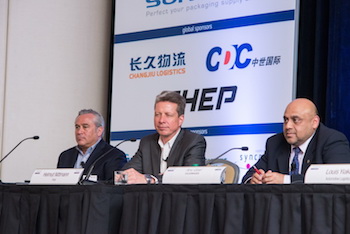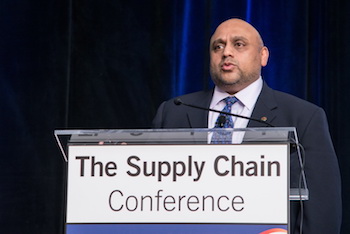The increase in vehicle recalls, from safety to emissions issues, is putting more pressure on OEM supply chains to find parts, store more inventory and manage expectations, write Marcus Williams and Christopher Ludwig in Atlanta

Over recent years, vehicle recalls have become an almost weekly feature of the automotive industry in the US, whether it is a safety issue or a voluntary one, one that affects 50,000 vehicles. The impact of such recalls can be significant for a car brand, whether in customer reputation, preventing lawsuits and indeed in operational costs.
For logistics and supply chain, recalls represent a complex set of procedures that impact the service parts logistics network, together with production schedules at car plants and tier suppliers, transport and inventory costs, as well as available space and service capacity at dealers. In some cases, such as the ongoing Takata airbag inflator recall, or the Volkswagen diesel emission ‘defeat device’, the uncertainty around an exact fix and its timing can be particularly difficult for the supply chain.
At the first Automotive Logistics Supply Chain Conference in Atlanta, Georgia aftermarket logistics experts from Ford, Toyota and Volkswagen discussed the efforts they were making to remedy the complex problems associated with the different types of repairs and customer follow up required following a recall.
Helmut Nittmann, global director of parts supply and logistics at the Ford Customer Service Division, which is responsible for service parts across the carmaker, said the company has seen a lot more activity in recalls over recent years, with real impacts for logistics.
“The inventory that we have to support those recalls is now about four times higher than it was 5-6 years ago,” said Nittmann. “On the plus side, Ford is catching issues a lot earlier, which definitely helps on the total cost.”
 Ford's Helmut NIttmann said that communication with government, suppliers, plant and customers were essential during a recall
Ford's Helmut NIttmann said that communication with government, suppliers, plant and customers were essential during a recallHe maintained that any recall required close communication, both with officials, engineers, dealers and suppliers. For example, Ford holds weekly meetings with the Automotive Safety Office (ASO), which is the main point of contact with the National Highway Traffic Safety Association (NHTSA), the federal body responsible for recalls and which has taken over direct oversight of the Takata airbag inflator recall. These meetings involve service engineers who determine where the vehicles that need to be recalled are located among the population.
After that point, the Ford engineering department is engaged to find a fix. Nittmann said that this could involve considerable variations in complexity, whether in volume, or in the actual repair. At one end it might be a simple software upgrade rather than a physical part; but often recalls require engineering, such as for a safety component that has to be redeveloped or engineered – or there might not even be a fix for many months.
Nittmann pointed out that one of the logistics challenges for a recall was in the uneven response rate among customers to bring in their vehicles to be serviced. Ford typically sees 30% or so of affected customers respond in the first 60-90 days, which usually peaks after 6-8 months at around 70% of customers who bring cars in to service centres – although the NHTSA is working on encouraging more customers to participate.
Anu Goel vice-president of parts and vehicle logistics at Volkswagen Group of America, agreed that the difference between recalls, including those related to safety, homecare or emissions, tended to elicit big disparities in response.
“If you are a mom driving around and you hear about a brake issue on your vehicle, you want it fixed immediately,” he said. “Now you are talking about a parts build and whether the dealer has the service capacity, and how long the customer is prepared to wait with the defect. How do you meet all these expectations?”
In terms of stock parts for the dealerships, Goel said that on a recalls 'go-live date' the company looks to have between 40-60% of the required parts inventory at the dealerships to support the demand because that is what is typically required within the first 60-90 days.
“We use a process called targeted allocation,” he said. “We know the VINs tied up in each region and populate the dealerships with the parts so they don't have to order. Then we repair and replace the part used. It is a fair distribution model.”
Eduardo Huante, general manager of service parts and accessories supply at Toyota’s North American Parts Operations, added that the difference between safety recalls and voluntary ones relating to the lifecycle of the car demanded significantly different capacity planning approaches. For safety, carmakers have to move quickly and are unlikely to have much time to plan their inventory or logistics.
“Plus, it is a huge inventory burden. We have to maintain inventory for the life of those vehicles on the road until the registered vehicles are fixed, whether they come in or not,” said Huante. “That is made difficult by the fact that customers are not as motivated to respond to recalls as they used to be.”
Voluntary recalls allow for more time, which allows Toyota to do capacity order planning on this side of the business. “We plan supply, generally about 30% of that up front, and then let it operate on daily orders as much as possible,” heexplained.Every recall is a snowflakeDifferent recalls also must elicit different responses for an OEM’s parts supply chain. If the recall requires an existing part, carmakers have to get the part out of production, which could be difficult especially if a supplier or component plant already has a limited capacity. Although service parts demand is typically much lower than that of production parts, a recall could suddenly impact several million vehicles – several times the level of a typical assembly plant’s annual volume.
A new part, meanwhile, needs to be validated and approved before it can be distributed. Anu Goel pointed out that carmakers need to be especially careful about making sure they have validated a delivery kit of repair parts. “Can you imagine if you bring a customer in and then the parts delivery is missing an ancillary parts, like a nut, screw, bolt or gasket?” he said. “Having a robust validated repair procedure is key.”
 Volkswagen's Anu Goel said that different types of recalls required different responses across the supply chain
Volkswagen's Anu Goel said that different types of recalls required different responses across the supply chainWith the increase in recalls and the growing complexity and volume that they represent, identifying the difference between each recall and its strategy is important for manufacturers, and for their customers. Ford's Nittmann emphasised that it is important that end users and dealers understand the process and pointed out that that was part of the close communication networks it set up, which also included parts supply.
“Every recall has a different twist,” he said. “Communication is important across Ford, both in engaging the Ford part design and production process, but also our dealers and customers.”
“Our quality engineers say campaigns and recalls that come out are like snowflakes, each one is different,” added Ed Huante. “The key is working hard to separate the variation that is created by that type of business.”
Huante also pointed out that Toyota now makes efforts to separate the logistics process for recall activity from its normal delivery network insomuch as possible. For example, recall parts are not usually sent to Toyota’s regional distribution centres, and are instead held in the network’s “first tier” parts centres (located in Ontario, California and Hebron, Kentucky), and then move directly to dealers.
“If we tried to manage campaign parts the same we order our daily parts we would drive ourselves crazy,” he said. “We have to accommodate the variation with an individual supply chain to make it work for the customer, the dealerships distribution centres and suppliers.”
A video of the aftermarket session of the Supply Chain Conference can be found here.


































